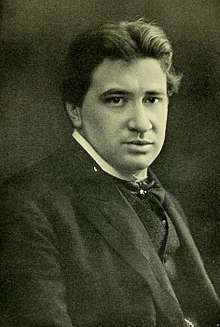Le donne curiose
Le donne curiose (English: The Inquisitive Women) is an opera in three acts by Ermanno Wolf-Ferrari to a text by Luigi Sugana after Carlo Goldoni's play.
| Le donne curiose | |
|---|---|
| Opera by Ermanno Wolf-Ferrari | |
 The composer in 1906 | |
| Translation | The Inquisitive Women |
| Librettist | Luigi Sugana |
| Language | Italian |
| Based on | Le donne curiose by Carlo Goldoni |
| Premiere | |
Performance history
The first dramatic work by Wolf-Ferrari to achieve more than local notice, it was first performed in Munich on 27 November 1903 in a German translation as Die neugierigen Frauen. The first performance in Italian was in New York on 3 January 1912 with a distinguished cast led by Arturo Toscanini, including Geraldine Farrar and Hermann Jadlowker. Tullio Serafin conducted the first performance in Milan on 16 January 1913.
Roles
| Role | Voice type | Premiere Cast, 27 November 1903 (Conductor: Hugo Josef Rheinberger) |
First performance in Italian, 3 January 1912 (Conductor: Arturo Toscanini) |
|---|---|---|---|
| Arlecchino | bass | Georg Sieglitz | Antonio Scotti |
| Beatrice | mezzo-soprano | Charlotte Huhn | Rita Fornia |
| Colombina | soprano | Hermine Bosetti | Geraldine Farrar |
| Florindo | tenor | Hans Koppe | Hermann Jadlowker |
| Leandro | tenor | Hans Breuer | Jeanne Maubourg |
| Lelio | baritone | Andres de Segurola | |
| Ottavio | bass | Paul Bender | Adam Didur |
| Pantalone | baritone | Friedrich Brodersen | Antonio Pini-Corsi |
| Rosaura | soprano | Ella Tordek | Bella Alten |
| Lunardo | bass | ||
| Mènego | bass | ||
| Mómolo | bass | ||
| Eleonora | soprano | ||
| Asdrubale | tenor | ||
| Almorò | tenor | ||
| Alvise | tenor | ||
| First gondolier | tenor | ||
| Second gondolier | bass | ||
Synopsis
The story is a comedy set in 18th-century Venice about two wives checking up on the goings-on at their husband's club.
Style
Wolf-Ferrari is an eclectic. The artistic lineage of Le donne curiose is plainly traceable to Mozart, though the influence of both Die Meistersinger and Falstaff is apparent. The orchestra is a relatively small one and in some respects the treatment harks back to an earlier day, when leading motives were less known. The music is distinguished by lyric simplicity and rhythmical variety. The prevailing character is improvisational, well adapted to the slight tale of harmless intrigue which it accompanies. There are several easily recognized numbers: the trios in the first act, the quartet in the second, Rosaura's love soliloquy and the succeeding pages of almost Mozartean simplicity, the prelude to the last act, the barcarolle chorus and the final ensemble.
Gallery
 The men at their club, Act I
The men at their club, Act I Geraldine Farrar and Hermann Jadlowker as Rosaura and Florindo
Geraldine Farrar and Hermann Jadlowker as Rosaura and Florindo A scene from Act III
A scene from Act III
Notes
References
- Amadeus Almanac, accessed 2 October 2008 (premiere)
- Amadeus Almanac, accessed 2 October 2008 (New York premiere)
- Warrack, John and West, Ewan (1992), The Oxford Dictionary of Opera, 782 pages, ISBN 0-19-869164-5

External links
- Le donne curiose (Wolf-Ferrari, Ermanno): Scores at the International Music Score Library Project (IMSLP)